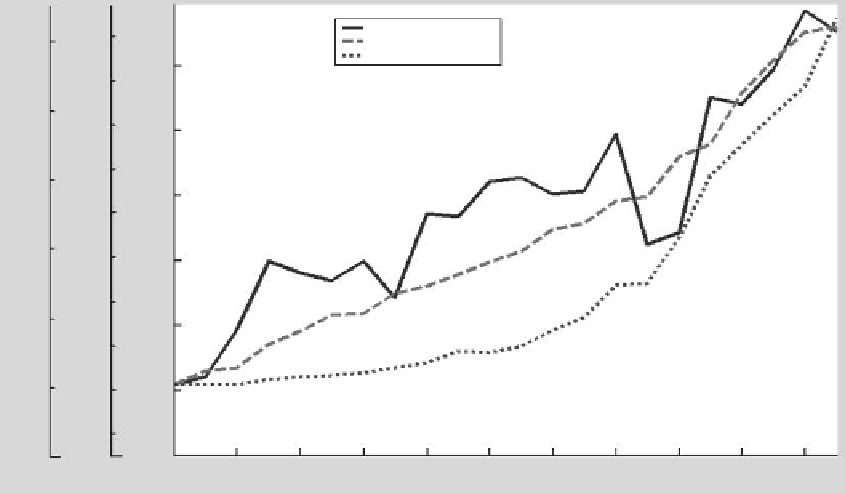Environmental Engineering Reference
In-Depth Information
Food grain production
Area under cultivation
Fertilizer consumption
38
25
100
36
20
34
90
32
15
80
30
10
28
70
26
5
60
24
0
22
50
20
4
1950
-5
1952
1954
1956
1958
1960
Ye ar
1962
1964
1966
1968
1970
FIGURE 15.10
Closer view of the increase in food production in the early years of the green revolution. Increase in food pro-
duction is more closely linked to the amount of irrigated land rather than the adoption of chemical fertilizers.
(Data from RBI,
Handbook of Statistics of the Indian Economy 2008-09
. Reserve Bank of India, Alco Corporation
[for RBI], Mumbai, pp. 50-85, 2009.)
groundwater level to depths that are not sustainable. We do believe that a severe water
crisis is looming on the horizon.
Even eminent scientists who fostered the green revolution acknowledge its limitation
and concur with the fact that traditional and organic closed-loop systems are necessary
if we have to revive and sustain food production in the future. Unlike that with chemical
fertilizer use, with organic farming practices, the soil nutrient increases every year with a
consequent increase in its capacity to be productive (Fukuoka 1978). Furthermore, this will
ensure a closed-loop regulated water use, which means that overexploitation of ground-
water would be unnecessary. If one has to go back to a situation where the fresh potable
groundwater is available, then one should revive the closed-loop agriculture by irst desilt-
ing and recovering existing lakes and ponds.
We would like to explain with some other examples and put forward an idea on how
to make the use of materials sustainable. J.C. Kumarappa (1957), hailed as the Gandhian
economist, had irst postulated the idea of sustainability way back in the 1950s where he
deined a sustainable society as one that manages
its (economic) growth in such a way as to do
no irreparable damage to its environment
. Causing no irreparable damage is in effect to oper-
ate a closed cycle. Further, Buckminister Fuller, the famous architect-engineer, refers to
planet Earth as
spaceship
earth. So true is this statement that most space stations today are
able to sustain themselves, simply by drawing energy from the sun, because of a closed-
loop resource and nutrient cycle that has been designed and built in the spaceship.
In the preceding paragraphs, it was explained how opening the loop has led to a com-
pletely unsustainable cycle. And, more important, one must remember that the effects of

